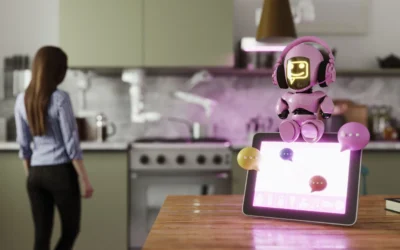Recruiting is a hard job by any standard. Now, as droves of employees are walking away from their desks during what’s has been dubbed the “Great Resignation,” it’s even more difficult. Applying artificial intelligence (AI) to recruiting may help recruiters smooth over the bumps that lie ahead.
The top recruiting challenges, according to Monster’s “The Future of Work 2021,” include:
- The gap between skills needed and skills available is widening. Almost a third of employers say the skills gap has increased compared to last year. Now, 85 percent of employers say they have difficulty filling openings due to a lack of the right expertise.
- Virtual recruiting is on the rise, but everyone is still learning how to do it right. Recruiters say their hiring process today is 75 percent virtual. Lingering concerns about COVID are influencing this trend. There’s also pressure from above to hire virtually to speed up the process and cut costs. But 28 percent of recruiters admit that they are still getting used to doing their jobs without meeting candidates face-to-face.
- Recruiters still aren’t sure how to assess candidates effectively. They find it difficult to identify quality candidates quickly (44 percent), to screen candidates before the interview (41 percent), and to accurately evaluate candidates during the interview (42 percent).
With recruiting workloads higher but resources staying the same—or even shrinking—recruiters today need to do more with less. Dwindling time, money, and support mean more and more of them are turning to recruiting AI.
AI use is growing among small businesses
Recruiting professionals are not alone. More and more small businesses are adopting AI. AI can help automate time-consuming processes that may require special expertise, like marketing, that small businesses don’t possess. It can also help streamline retail operations and protect small businesses from e-commerce fraud. And now we’re seeing applications in hiring and recruiting.

Recruiting AI is increasingly the norm in HR
According to a study by the HR Research Institute, 96 percent of HR managers say AI will eventually be an immense help in acquiring talent. Just over half (55 percent) predict that AI will be a recruiting standard within five years.
Recruiting AI applies to when artificial intelligence meets talent acquisition. It comes into play for many HR functions, like writing job ads, screening resumes, and interviewing candidates. It can also be a handy tool for coordinating with hiring managers and extending offers.
Different aspects of the recruiting process can also be automated by recruiting AI. It helps recruiters work more efficiently so they can concentrate on hiring the best candidates. Essentially, recruiting AI helps HR professionals do what humans do best: build relationships.
Will AI take over the entire recruiting and hiring process? Probably not. At this stage of AI technology, no one wants it to take over the end-to-end recruiting process. When it comes to hiring, it’s important to keep humans in the loop to avoid the potential pitfalls of AI.
Watch out for recruiting AI gotchas
When it came on the market, AI recruiting software was rightly panned for biases in its algorithms. Some AI-powered applicant tracking systems (ATS) were based on natural language processing techniques. Any candidate that failed to use the exact keywords in the job description was automatically filtered out. In a well-publicized example, an AI recruiting system under development systematically rejected women candidates. This happened because it had been trained on the firm’s existing, predominantly male employee pool. Given today’s drive for diversity and inclusion in hiring, any primitive AI system that “learned” what to do based on historical patterns clearly isn’t going to fly.
However, leading workforce management system providers have since adjusted their algorithms to address this issue. Plus, a growing list of legislation, both in the United States and abroad, keeps a close eye on bias in AI systems. This is especially important when it comes to hiring practices. The goal is to keep the recruiting AI marketplace fair.
How recruiting AI can help HR professionals
The many ways AI can help recruiting are already becoming apparent. Here’s a list of the most prominent ones.
Screen resumes
Having to manually go through mountains of resumes remains the most time-consuming part of recruiting. It is a frustrating job, and according to a survey by Robert Half, 42 percent of applicants fail to meet minimum skill requirements. Screening resumes is estimated to take up to 23 hours for just one hire.
Artificial intelligence technologies can analyze existing company data on successful past hires. Then, it finds the right hires by matching candidates’ skills, experience, and knowledge with job requirements. The software learns which previous hires went on to be successful employees. It can also determine which ones failed based on performance, tenure, and turnover rates. Keywords are still important, but AI systems can now “learn” as more data is fed into them. They can understand synonyms and alternate ways candidates describe their education and job experience. It all adds up to a more organic, flexible way to seek qualified potential employees.
The AI recruiting software can also augment candidates’ resumes. It can find mentions of them in public data sources about prior employers and public social media profiles. AI technology applied to this task can also rank, grade, and shortlist the strongest candidates to make things even easier on recruiters.
The result of this kind of screening? There is a better chance of good hires, and more satisfied and engaged employees who are less likely to churn.

Enlarge the talent pool
With AI, recruiters don’t have to wait for resumes to hit their inboxes. They can more proactively search for qualified candidates using the tools currently available.
Take so-called “passive” candidates—people who are not actively seeking jobs. The pool of qualified passive candidates may even be larger than active job seekers. AI empowers recruiters to efficiently search the company’s own ATS database, social media, trade publications, conference speakers and attendees, and even the open web to seek out qualified candidates. AI can do in seconds what would take weeks to do manually.
Analyze video interviews
AI is even getting into the interview room with talent acquisition professionals. Remote interviews have become the norm, especially with COVID-19. New video interview platforms are emerging that look at recorded videos of interviews. They can analyze the footage to help recruiters understand candidates’ personalities in ways that might not have been obvious to them. For example, some use facial recognition and natural language processing (NLP) technologies. Facial recognition is used to analyze candidates’ facial expressions, to see what they might reveal about their emotions and feelings masked by their spoken words. NLP does the same for language. It analyzes speech patterns and looks to match those of successful hires. There are even technologies said to identify how confident and engaged a particular job seeker would be if hired.
Perform tech screening
When hiring for IT or other technical positions, many companies want to assess candidates’ technical prowess. Today, automated tech assessments are becoming commonplace as a way of screening engineers. For example, AI can figure out the relative quality of answers to questions to determine a candidate’s facility with different programming languages.
Schedule candidates
Scheduling candidates for interviews can be time-consuming, especially when they need to meet with multiple people from the hiring team. Often, the process involves too much phone and email tag before a time slot can be agreed upon. AI-infused scheduling software makes all the headaches go away. Basically, it helps keep all the balls in the air and ensures that no one is overlooked or forgotten. Everyone—including the candidate—has a much better experience connecting.
Recruit with chatbots
Most people who visit your website’s career page probably won’t apply for a job. If you create an AI-based chatbot you can ask visitors questions about their goals, salary requirements, and benefits preferences in a natural, human-sounding way. This type of AI might just entice more visitors to submit their resumes.
In conclusion: recruiting is serious business—let AI give you a helping hand
According to Robert Half, the average cost of a bad hire can be between 15 and 21 percent of that employee’s salary, depending on seniority. Other experts say adding the hiring costs, total compensation, training, and the cost of disruption that a poor fit can cause, can drive that price far higher. So, the mistake of hiring the wrong candidate can be a serious one. The good news is that today’s recruiters have an increasing spread of AI tools at their disposal. Tools that can make them more efficient when matching the right person with the right job. This way, they can use their very human strengths of relationship building and judgment to best effect.
For more on small business, please visit the Work section of the Quantum Fiber Explore blog.








